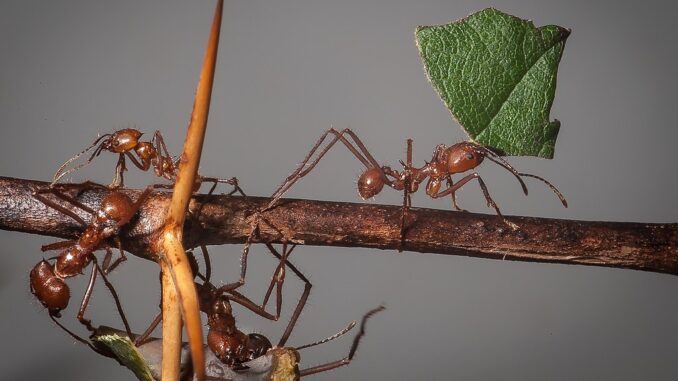
You may recall from an earlier episode of the Night Owl that ants are my mortal enemies. I have harbored no respect for them whatsoever, and have killed hundreds, probably thousands of them whenever they unwisely invaded my space (literally with my bare hands, including fire ants – no kidding – there’s a technique to it to avoid stings). However, several facts concerning ants have recently come to my attention and I must now concede that ants deserve at the very least my grudging respect.
First, I learned while reading about Hymenoptera a few months ago that bees, wasps, and ants, are all closely related and scientifically classified as belonging to the same order: Hymenoptera. Considering that bees and wasps have become my favorite animals from the world of insects, it seems oddly incongruous that ants should not be thought of in the same vein.
Second, recently I’ve read some fascinating facts about Acromyrmex echinatior, a leaf-cutter ant indigenous to Central America. These little buggers were most likely the Earth’s first farmers, having learned how to raise their own food something like 15 million years or more before humans did. They gather leaves, grass, and flowers, haul it back to their nest, and feed the collected vegetation to the fungus that live with them in the ant colony. Adult ants consume leaf sap to survive, but ant larvae feed off the fungus grown by the adults. Without the ant colony, the fungus cannot survive, and without the fungus to eat, the ant larvae would not survive, which means the entire colony collapses and dies. [Note that there are 47 species of leaf-cutter ants, and each one cultivates a different fungus species from the family Lepiotaceae].
Apparently, though, the ant-fungus symbiotic relationship was not enough: there’s also a bacteria that is symbiotic with the ants. This bacteria kills a parasitic fungus that would destroy the ant’s cultivated food-source fungus. This is amazing! Ants have learned to manage and cooperate with both fungus and bacteria. Three species from three different classification Kingdoms, working together for mutual benefit. That’s like three alien races from three different planets getting together and finding they can help each other survive. The three together are stronger than any one of them alone.
Lastly, the journal Nature published a paper November 24, 2020, titled Biomineral armor in leaf-cutter ants, describing the astounding discovery that Acromyrmex echinatior makes it’s own stoney outer layer of rock armor. Now and again, ants battle to the death against ants from other colonies, in which limbs are torn asunder. All ants have exoskeletons, providing a basic layer of armor, but the advantage goes to the species with the best, most improved, armor. The new discovery is described as plates of a biomineral with properties akin to dolomite that cover the adult exoskeleton of A. echinatior, giving them an edge in battle. More fascinating is the fact that the young of the species don’t have this rock-plate armor. If the young are taken from the nest before they acquire the biomineral armor, they never will have it. Somehow the adult ants make the armor plates!
A. echinatior is a leaf-cutter species which has been extensively studied by science with thousands of scholarly papers written about this common and familiar ant. It is one of the most-well known and most-intensely studied of insect species, and yet humans have just learned something radically new and remarkable about them. What we don’t know about other insect species that haven’t been deeply scrutinized must be mind-blowing!
Question of the Night: If armor-plated exoskeletons for humans suddenly became available, were affordable, comfortable, and removable for easy cleaning, would you want one?
